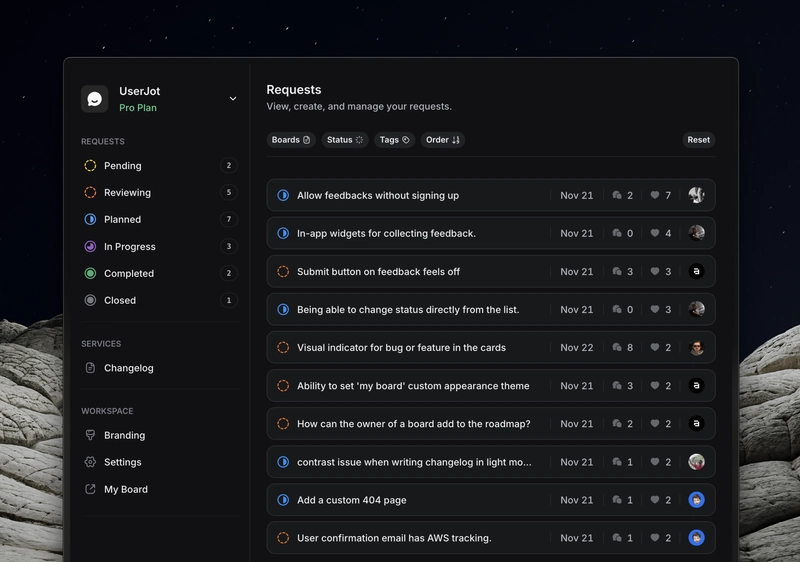Top 5 Usersnap Alternatives in 2025
You're probably here because you're looking for alternatives to Usersnap. Maybe you want something simpler, more affordable, or with different features. Whatever your reason, we've gathered five great options worth considering. Let's jump straight into the list, starting with a tool that's gaining popularity fast: UserJot. 1. UserJot UserJot is a modern, user-friendly tool designed specifically to collect and manage user feedback. It helps teams easily gather feature requests, bug reports, and user ideas in one place. With a clean and intuitive interface, UserJot makes it simple to engage your users, prioritize their suggestions, and keep everyone informed with transparent roadmaps and changelogs. It's ideal for startups, SaaS companies, and product teams who want to build exactly what their customers need without complicated features getting in the way. You can check it out at UserJot. Pros: Unlimited feedback posts and users, even on the free plan. Easy voting system helps prioritize user requests. Smart AI-powered tagging for automatic organization. Public roadmap and integrated changelog features. Custom branding and custom domain available on paid plans. Simple pricing with a generous free tier. Fast, reliable, and responsive customer support. Pricing: Free: Unlimited posts, unlimited users, 2 feedback boards, public roadmap & changelog, 3 admin roles. Starter ($29/month, 2-week free trial): Custom domain, branding, guest posting, private boards, integrations, 5 boards. Professional ($59/month, 2-week free trial): Unlimited boards, unlimited admin roles, priority support, Single Sign-On (SSO). 2. Canny.io Canny.io is a feedback management platform that helps teams collect, organize, and prioritize user requests. It allows users to submit and vote on ideas, giving product teams clear insights into what's important. Canny integrates well with popular tools like Jira and Slack, making it easier to fit into your workflow. It's best suited for teams looking for solid integrations and detailed analytics. Pros: Good integration options (Slack, Jira, Intercom). Public roadmap to share progress. User-friendly and intuitive interface. Effective moderation and merging of duplicate feedback. Advanced analytics on higher plans. Cons: Higher pricing compared to other options. Limited features on lower-priced plans. No anonymous feedback option. Some users find prioritization tools basic. Occasional interface usability issues. Pricing: Free: 100 active posts, 1 integration, 3 admins. Starter ($99/month): Unlimited posts, 2 integrations, custom domain. Growth ($399/month): Advanced analytics, unlimited integrations, user segmentation. Business: Custom pricing, advanced integrations, SSO, white labeling. 3. Fider.io Fider.io is an open-source feedback management tool that offers both cloud-hosted and self-hosted options. It's simple, easy to use, and budget-friendly. Users can submit ideas, vote, and discuss suggestions. Fider is a good choice if you prefer open-source solutions or want full control over your feedback data. Pros: Simple and intuitive user interface. Open-source and customizable. Affordable cloud-hosted option. Easy to set up and manage. Supports multiple login methods (OAuth2). Cons: Lacks built-in public roadmap and changelog features. Limited analytics and reporting. Basic feedback moderation features. No built-in spam protection. Limited direct customer support. Pricing: Cloud: $30/month, unlimited users, custom domain, full features. Self-hosted: Completely free, requires technical setup and hosting. 4. UserReport UserReport combines surveys and feedback widgets to help you understand your users better. It collects demographic data, user satisfaction scores (like NPS), and lets users submit ideas and bug reports. UserReport integrates smoothly with Google Analytics, making it ideal for teams who want to combine feedback data with website analytics. Pros: Free basic version available. Integrates with Google Analytics for deeper insights. Mobile-friendly feedback widgets. Multi-language support. Easy to set up and use. Cons: Unclear pricing for advanced features. Limited recent user reviews and case studies. Potential hidden costs for extra features. No built-in public roadmap. UI concerns mentioned by some users. Pricing: Free: Basic survey and feedback widgets. Paid Plans: Pricing not publicly clear; contact sales for detailed info. 5. UserVoice UserVoice is a well-established feedback platform that helps large teams manage user suggestions, prioritize features, and analyze feedback data. It provides detailed analytics, integrations, and enterprise-level security. UserVoice is suited for larger companies with complex feedback management needs and bigger budgets. Pro

You're probably here because you're looking for alternatives to Usersnap. Maybe you want something simpler, more affordable, or with different features. Whatever your reason, we've gathered five great options worth considering. Let's jump straight into the list, starting with a tool that's gaining popularity fast: UserJot.
1. UserJot
UserJot is a modern, user-friendly tool designed specifically to collect and manage user feedback. It helps teams easily gather feature requests, bug reports, and user ideas in one place. With a clean and intuitive interface, UserJot makes it simple to engage your users, prioritize their suggestions, and keep everyone informed with transparent roadmaps and changelogs. It's ideal for startups, SaaS companies, and product teams who want to build exactly what their customers need without complicated features getting in the way. You can check it out at UserJot.
Pros:
- Unlimited feedback posts and users, even on the free plan.
- Easy voting system helps prioritize user requests.
- Smart AI-powered tagging for automatic organization.
- Public roadmap and integrated changelog features.
- Custom branding and custom domain available on paid plans.
- Simple pricing with a generous free tier.
- Fast, reliable, and responsive customer support.
Pricing:
- Free: Unlimited posts, unlimited users, 2 feedback boards, public roadmap & changelog, 3 admin roles.
- Starter ($29/month, 2-week free trial): Custom domain, branding, guest posting, private boards, integrations, 5 boards.
- Professional ($59/month, 2-week free trial): Unlimited boards, unlimited admin roles, priority support, Single Sign-On (SSO).
2. Canny.io
Canny.io is a feedback management platform that helps teams collect, organize, and prioritize user requests. It allows users to submit and vote on ideas, giving product teams clear insights into what's important. Canny integrates well with popular tools like Jira and Slack, making it easier to fit into your workflow. It's best suited for teams looking for solid integrations and detailed analytics.
Pros:
- Good integration options (Slack, Jira, Intercom).
- Public roadmap to share progress.
- User-friendly and intuitive interface.
- Effective moderation and merging of duplicate feedback.
- Advanced analytics on higher plans.
Cons:
- Higher pricing compared to other options.
- Limited features on lower-priced plans.
- No anonymous feedback option.
- Some users find prioritization tools basic.
- Occasional interface usability issues.
Pricing:
- Free: 100 active posts, 1 integration, 3 admins.
- Starter ($99/month): Unlimited posts, 2 integrations, custom domain.
- Growth ($399/month): Advanced analytics, unlimited integrations, user segmentation.
- Business: Custom pricing, advanced integrations, SSO, white labeling.
3. Fider.io
Fider.io is an open-source feedback management tool that offers both cloud-hosted and self-hosted options. It's simple, easy to use, and budget-friendly. Users can submit ideas, vote, and discuss suggestions. Fider is a good choice if you prefer open-source solutions or want full control over your feedback data.
Pros:
- Simple and intuitive user interface.
- Open-source and customizable.
- Affordable cloud-hosted option.
- Easy to set up and manage.
- Supports multiple login methods (OAuth2).
Cons:
- Lacks built-in public roadmap and changelog features.
- Limited analytics and reporting.
- Basic feedback moderation features.
- No built-in spam protection.
- Limited direct customer support.
Pricing:
- Cloud: $30/month, unlimited users, custom domain, full features.
- Self-hosted: Completely free, requires technical setup and hosting.
4. UserReport
UserReport combines surveys and feedback widgets to help you understand your users better. It collects demographic data, user satisfaction scores (like NPS), and lets users submit ideas and bug reports. UserReport integrates smoothly with Google Analytics, making it ideal for teams who want to combine feedback data with website analytics.
Pros:
- Free basic version available.
- Integrates with Google Analytics for deeper insights.
- Mobile-friendly feedback widgets.
- Multi-language support.
- Easy to set up and use.
Cons:
- Unclear pricing for advanced features.
- Limited recent user reviews and case studies.
- Potential hidden costs for extra features.
- No built-in public roadmap.
- UI concerns mentioned by some users.
Pricing:
- Free: Basic survey and feedback widgets.
- Paid Plans: Pricing not publicly clear; contact sales for detailed info.
5. UserVoice
UserVoice is a well-established feedback platform that helps large teams manage user suggestions, prioritize features, and analyze feedback data. It provides detailed analytics, integrations, and enterprise-level security. UserVoice is suited for larger companies with complex feedback management needs and bigger budgets.
Pros:
- Advanced analytics and reporting.
- Integrates with Salesforce, Jira, Slack, and more.
- Strong security and compliance features.
- Good for managing large amounts of feedback.
- Centralized feedback management.
Cons:
- Expensive pricing for small teams.
- Can be complex and less intuitive.
- Limited customization options.
- No built-in changelog.
- Overwhelming features for simpler needs.
Pricing:
- Growth ($899/month): Up to 1,000 end users, basic integrations.
- Team ($1,199/month): Up to 3,000 end users, advanced integrations.
- Strategic ($1,349/month): Up to 5,000 end users, detailed analytics.
- Enterprise: Custom pricing, advanced security, premium features.
Final Thoughts
Choosing the right Usersnap alternative depends on your team's specific needs. Here are some key criteria to consider:
- Affordability: UserJot and Fider.io offer great value, especially for smaller teams.
- Ease of Use: UserJot and Fider.io stand out with simple, intuitive interfaces.
- Advanced Analytics: UserVoice and Canny.io offer detailed analytics, suitable for larger teams.
- Open-source Preference: Fider.io is the clear choice if you prefer open-source solutions.
- Roadmap and Changelog: UserJot includes integrated public roadmaps and changelogs, making it easy to keep users informed.
Remember, pricing and features can change, so always double-check the current details. Hopefully, this helps you find the perfect tool to manage your user feedback effectively.







































































































































































![[The AI Show Episode 143]: ChatGPT Revenue Surge, New AGI Timelines, Amazon’s AI Agent, Claude for Education, Model Context Protocol & LLMs Pass the Turing Test](https://www.marketingaiinstitute.com/hubfs/ep%20143%20cover.png)




































































































































![From drop-out to software architect with Jason Lengstorf [Podcast #167]](https://cdn.hashnode.com/res/hashnode/image/upload/v1743796461357/f3d19cd7-e6f5-4d7c-8bfc-eb974bc8da68.png?#)










































































































.jpg?#)





.png?width=1920&height=1920&fit=bounds&quality=70&format=jpg&auto=webp#)
























_ArtemisDiana_Alamy.jpg?#)















































































-xl.jpg)













![Yes, the Gemini icon is now bigger and brighter on Android [U]](https://i0.wp.com/9to5google.com/wp-content/uploads/sites/4/2025/02/Gemini-on-Galaxy-S25.jpg?resize=1200%2C628&quality=82&strip=all&ssl=1)












![Apple Rushes Five Planes of iPhones to US Ahead of New Tariffs [Report]](https://www.iclarified.com/images/news/96967/96967/96967-640.jpg)
![Apple Vision Pro 2 Allegedly in Production Ahead of 2025 Launch [Rumor]](https://www.iclarified.com/images/news/96965/96965/96965-640.jpg)































































































































